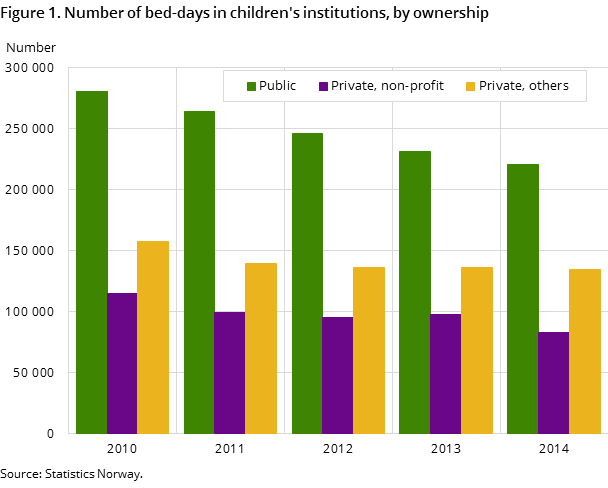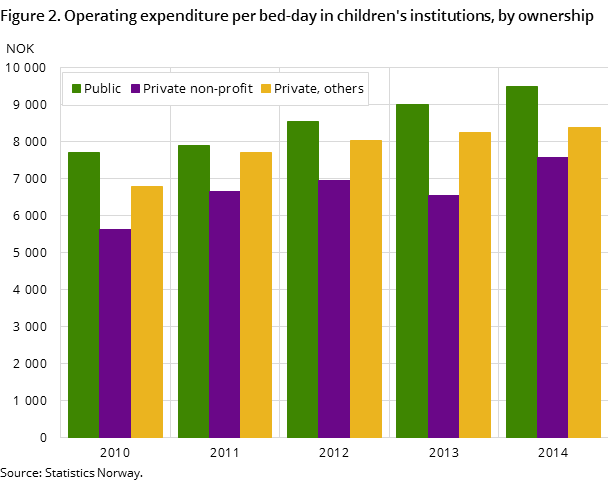Content
Published:
This is an archived release.
Less activity in institutions
In 2014 there were 6 per cent less bed-days in children’s institutions compared to the year before. Since 2010 the activity measured in bed-days is reduced by 21 per cent.
| Absolute figures | Per cent | ||
|---|---|---|---|
| 2014 | 2013 - 2014 | 2010 - 2014 | |
| 1Maternity homes are from the year 2010 included in the number of beds. | |||
| Number of beds1 | 1 767 | 1.3 | -8.8 |
| Number of children i childrens institutions | 1 227 | -1.5 | -13.9 |
| Treatment days (stays) during the year | 437 908 | -5.9 | -20.9 |
| Operating expenditures (NOK million) | 3 849.4 | -0.1 | -0.9 |
| Operating expenditures per treatment days | 8 791 | 6.2 | 25.3 |
| Publicly owned institutions | 9 483 | 5.1 | 8.9 |
| Owned by ideal private institutions | 7 589 | 15.8 | 34.7 |
| Owned by other private institutions | 8 393 | 1.7 | 23.5 |


A total of 437 900 bed-days were registered in children’s institutions in 2014. This is 27 700 fewer than in 2013. The decline is mostly in private non-profit institutions, with a 16 per cent drop in 2014. Also in publicly-owned institutions, i.e. institutions owned by Oslo municipality together with the state-owned institutions, there was a decrease of almost 5 per cent, while other private institutions had a decline of just over 1 per cent from 2013 to 2014.
One half of the bed-days in 2014 were in publicly-owned institutions, 19 per cent in private non-profit institutions and 31 per cent in other private institutions.
Fewer bed-days in all regions
There were fewer bed-days in all regions, and the decline was least significant in the East region with less than 3 per cent. This is mostly explained by the increase in bed-days from 24 000 in 2013 to 29 000 in 2014 for unaccompanied juvenile asylum seekers, all of whom are registered in region East.
More acute stays
Care stays, which also include unaccompanied juvenile asylum seekers, were the most common (38 per cent) type of stay. Voluntary stays accounted for 28 per cent and behavioural stays 17 per cent. Acute stays accounted for 15 per cent of total stays, which is an increase from 11 per cent in 2012.
A total of 1 227 children were institutionalised at the end of 2014, compared to 1 246 a year earlier. Thirteen per cent of all resident children were aged 12 years or younger, and more boys than girls were institutionalised (60 per cent boys).
Increase in expenditures in non-profit institutions
The institutions’ operating expenditure amounted to almost NOK 3.9 billion in 2014; about the same level as in 2009-2013. Operating expenditure per bed-day was on average NOK 8 800. Stays in publicly-owned institutions are about NOK 700 more expensive than this on average. The private non-profit operating expenditure per bed-day was NOK 7 500; an increase of just over NOK 1 000, while in other private institutions the operating expenditure per bed-day was about NOK 8 400; about the same level as in 2013.
Increase in man-years
There was an increase of almost 5 per cent in the number of contracted man-years adjusted for sick-leave and maternity leave in children’s institutions between 2013 and 2014. The increase is mostly explained by a correction in region West, which has reported errors to the data source for the statistics for both 2012 and 2013.
Man-years region West Open and readClose
Region West had deficiencies in both 2012 and 2013 in the reporting of data for personnel in the institutions in the Employer and Employee Register, which is the source register for the statistics. Some personnel have wrongly been linked to the administration unit in the region. Administration is not included in these statistics and the level of man-years in institutions is too low for these two years.
A new registering system - BiRKOpen and readClose
In 2014, all regions in Bufetat implemented BiRK as their new system for registering child welfare. This transition from ODA to BiRK causes some deficiencies and insecurities in the registrations and then in the numbers for the activity in the institutions in 2014.
Contact
-
Tone Dyrhaug
E-mail: tone.dyrhaug@ssb.no
tel.: (+47) 40 90 24 20
-
Unni Beate Grebstad
E-mail: unni.grebstad@ssb.no
tel.: (+47) 94 50 68 66
